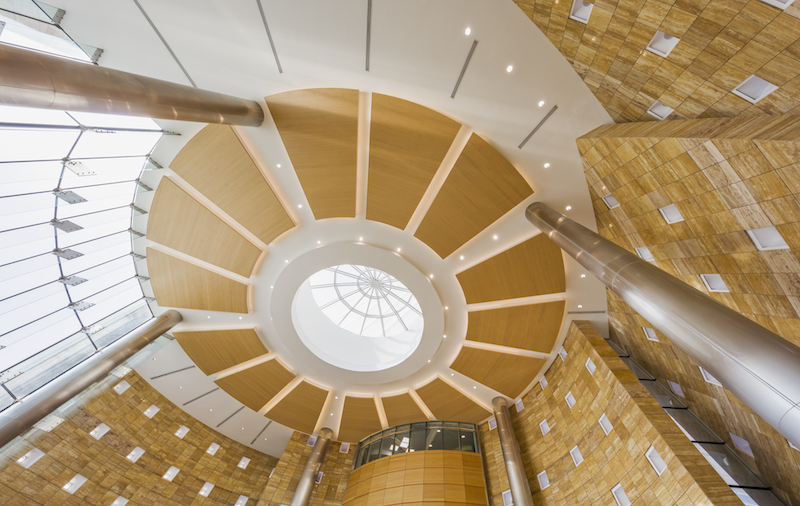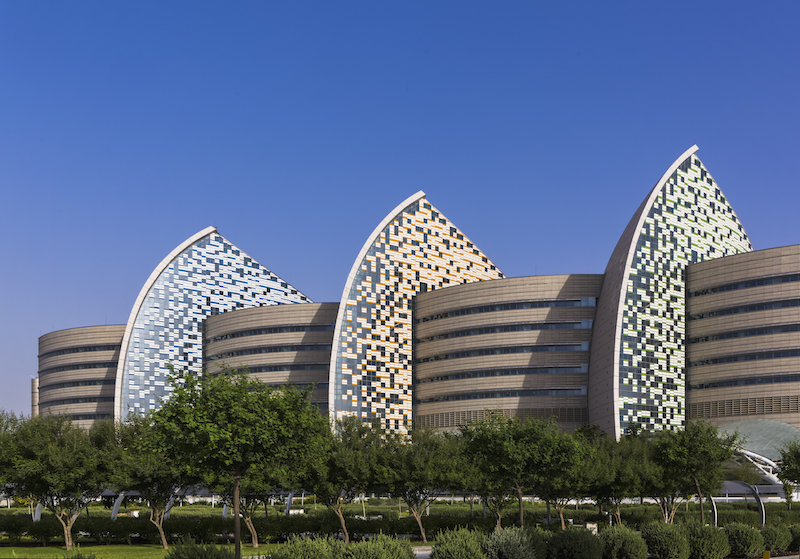This spring, the 1-million-sf Sidra Medicine in Doha, Qatar, is scheduled to launch a purpose-built clinic with in vitro fertilization services for reproductive consultation.
The hospital, which had its official opening on November 12, is one of the few in Qatar offering health services specifically for women and children. The facility, whose nearly $8 billion construction cost was endowed by Qatar Foundation, has more than 50 outpatient clinics and 400 inpatient beds, expandable to 550.
The hospital’s exterior design, by New Haven, Conn.-based Pelli Clarke Pelli Architects, is distinguished by three sails that take their cue from traditional boats known as dhows, and from sand patterns in Doha “that are quite beautiful,” says Mark Shoemaker, a Principal with Pelli Clarke Pelli. “These fluid forms inspired us.”

The hospital has three massive atriums, bathed in natural light. Image; Jeff Goldberg_Esto
The sails, clad in white ceramic tile, are part of massive atriums within the building, one of which includes a garden respite. The hospital also has a mosque, an ambulatory care center, and underground parking for 1,000 cars.
The medical center is positioned as a gateway to Education City, Doha’s 1.4-square-kilometer concentration of academic, science, and sports facilities. A tunnel connects the hospital directly to Cornell Weill Medical School, one of six campuses at Education City. (Other campuses are for Texas A&M, Carnegie Mellon University, and Virginia Commonwealth.)
The construction of Education City, which debuted in 1997, and Sidra Medicine was spearheaded by Sheikha Moza bint Nasser, chairperson of Qatar Foundation and consort to Sheikh Hamad bin Khalifa Al Thani, Qatar’s former Emir. Her Highness has been instrumental in advancing education and social reform in her country.
Shoemaker says Pelli Clarke Pelli was brought into the project by AECOM. (He once worked for Ellerbe Beckett, which designed the first Mayo Clinic. That firm is now part of AECOM). The team unveiled its design for Sidra Medical in 2007, and construction began in 2010.
Completion of the hospital was originally slated for 2011, and then 2015. The delays, explains Shoemaker, were partly attributable to the building’s size and complexity, but also to Building Team-related changes.
The hospital employs more than 4,000 people with 85 nationalities. Image: Sidra Medical and Research Center.
At one point AECOM left the project that then switched to a design-build delivery method led by Spain-based general contractor OHL, which had been in a joint venture with Contrack International for this project since 2008. Qatar Foundation fired OHL over delays in 2014, and OHL subsequently sued the foundation. Eventually, AECOM came back into the picture.
Sidra Medicine actually has been receiving patients since January 2018, and has staggered the opening of different departments—like robotic surgery last July. Shoemaker suggests this could be because Qatar doesn’t have enough trained medical professionals to meet the needs of such a large facility, and Sidra Medical has had to fill those gaps by recruiting (with Cornell Weill’s assistance) medical personnel from outside the country, mostly the United States and Europe.
When asked what his firm took away from this project, Shoemaker says that “it gave us the opportunity to experiment with different healthcare models for rooms and lobbies.” He adds that the design also paid attention to reflect Qatar’s culture.
Related Stories
Intelligent Lighting | Feb 13, 2023
Exploring intelligent lighting usage in healthcare, commercial facilities
SSR's Todd Herrmann, PE, LEEP AP, explains intelligent lighting's potential use cases in healthcare facilities and more.
Giants 400 | Feb 9, 2023
New Giants 400 download: Get the complete at-a-glance 2022 Giants 400 rankings in Excel
See how your architecture, engineering, or construction firm stacks up against the nation's AEC Giants. For more than 45 years, the editors of Building Design+Construction have surveyed the largest AEC firms in the U.S./Canada to create the annual Giants 400 report. This year, a record 519 firms participated in the Giants 400 report. The final report includes 137 rankings across 25 building sectors and specialty categories.
Giants 400 | Feb 6, 2023
2022 Reconstruction Sector Giants: Top architecture, engineering, and construction firms in the U.S. building reconstruction and renovation sector
Gensler, Stantec, IPS, Alfa Tech, STO Building Group, and Turner Construction top BD+C's rankings of the nation's largest reconstruction sector architecture, engineering, and construction firms, as reported in the 2022 Giants 400 Report.
Healthcare Facilities | Jan 31, 2023
How to solve humidity issues in hospitals and healthcare facilities
Humidity control is one of the top mechanical issues healthcare clients face. SSR's Lee Nordholm, PE, LEED AP, offers tips for handling humidity issues in hospitals and healthcare facilities.
Augmented Reality | Jan 27, 2023
Enhancing our M.O.O.D. through augmented reality therapy rooms
Perkins Eastman’s M.O.O.D. Space aims to make mental healthcare more accessible—and mental health more achievable.
Hospital Design Trends | Jan 19, 2023
Maximizing access for everyone: A closer look at universal design in healthcare facilities
Maria Sanchez, Interior Designer at Gresham Smith, shares how universal design bolsters empathy and equity in healthcare facilities.
Fire and Life Safety | Jan 9, 2023
Why lithium-ion batteries pose fire safety concerns for buildings
Lithium-ion batteries have become the dominant technology in phones, laptops, scooters, electric bikes, electric vehicles, and large-scale battery energy storage facilities. Here’s what you need to know about the fire safety concerns they pose for building owners and occupants.
Healthcare Facilities | Dec 20, 2022
4 triage design innovations for shorter wait times
Perkins and Will shares a nurse's insights on triage design, and how to help emergency departments make the most of their resources.
Healthcare Facilities | Dec 20, 2022
Designing for a first-in-the-world proton therapy cancer treatment system
Gresham Smith begins designing four proton therapy vaults for a Flint, Mich., medical center.
Cladding and Facade Systems | Dec 20, 2022
Acoustic design considerations at the building envelope
Acentech's Ben Markham identifies the primary concerns with acoustic performance at the building envelope and offers proven solutions for mitigating acoustic issues.

















